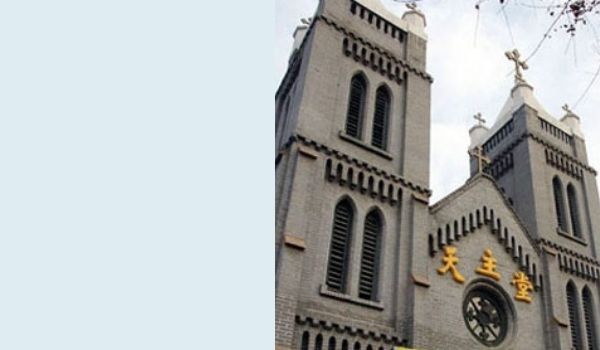
The diocese itself covers an area of 90,275 square kilometers, covering Chifeng city and its three districts, seven banners and two counties. They are the districts of Hongshan, Yuanbaoshan and Songshan; the banners of Ar Khorchin, Baarin Left Banner, Baarin Right Banner, Hexigten, Ongniud, Harqin, Aohan, and the counties of Linxi and Ningcheng. However, since Tungliao city and Xin'an League were also entrusted to its care, Chifeng's total area of jurisdiction is up to 360,000 square kilometers.
The whole area has a population of 4.37 million, among which 850,000 are Mongolian ethnics.
Mandarin and Mongolian language are in use in the diocesan territory.
Catholicism entered Chifeng as early as 1835. The territory was managed by the French Catholic Mission under the jurisdiction of Apostolic Vicariate of Eastern Liaoning in 1840 but by December of the same year, it became part of the new Apostolic Vicariate of Mongolia. In 1883, the Mongolic Apostolic Vicariate was divided into three. Chifeng fell into the Apostolic Vicariate of Eastern Mongolia, which was renamed into Jehol in 1922.
It was until 1932, the Prefecture Apostolic of Chihfeng (Chifeng) was erected. It was elevated into a diocese in 1949, after which the Church suffered from political turmoil.
After religious activities revived in 1981, six priests who were sent to reform-through-labor returned to the diocese. Father Qiao Zhanying became the diocesan administrator. Since the Church suffered much destruction, they had to start almost from scratch. In 1983, the diocese sent out the first batch of seminarians to Beijing Seminary for formation. Two years later, they sent the second batch to the Seminary in Hohhot, regional capital of Inner Mongolia Autonomous Region. At the same time, they also recovered Church properties and rebuilt new churches. After a decade of effort, the diocese saw much development.
In 1990, Father Andreas Zhu Wenyu was ordained bishop without papal mandate but he reached communion with the Vatican later. He died in 2006.
Chifeng is a transport hub connecting the eastern and western area of Inner Mongolia, northeastern and northern China. It is only 315 km from Beijing and thus it is nicknamed the beautiful "backyard of Beijing." There are 8 provincial or national highways linking Chifeng with surrounding cities.
There are 18 inland flights and 2 international flights reaching Chifeng from Hohhot, regional capital, Beijing, Ulaanbaatar, capital of the Republic of Mongolia. It also has 19 railway lines going to different parts of China and 5 local railway lines running in the city.
Chifeng has a four-season, monsoon-influenced, continental steppe climate, with long, cold, windy, but dry winters, and hot, humid summers. Monthly mean temperatures is about 10.7 °C (12.7 °F) in January and around 23.6 °C (74.5 °F) in July, with the annual mean at 7.5 °C (45.5 °F). Nearly half of the year's rainfall occurs in July and August, and even then dry and sunny weather dominates in the city.
Chifeng is rich in mineral resources with over 70 mineral deposits. The area is rich in coal, oil and gas; nonferrous metal and ferrous mental, namely iron, tin, zinc, lead, gold, silver, molybdenum etc. There are also non-metal minerals include limestone, marble, fluorspar, silica, pearlite, bentonite etc.
As for agricultural and animal husbandry products, besides the dominant crops of corn, rice, millet, there are cash crops like beans, buckwheat, sunflower seeds, sugar beets, tobacco, and Chinese herbals. Yearly yield of grains can reach 6 billion Chinese catties. The amount of livestock in the area is over 14 million.
Chifeng or Wulanhada in Mongolian, is located in southeastern Inner Mongolia. It was named by the Red Mountain in the northeast corner of this city. It borders Xilin Gol to the north and west, Tongliao to the northeast, Chaoyang city of Liaoning province to the southeast, and Chengde city of Hebei province to the south. The city has a total administrative area of 90,275 square kilometers.
There is the Chifeng University in the city.
According to archeology studies, human existence in Chifeng can be traced back almost 100,000 years, and the cultural history can be traced back nearly 8,000 years. The famous ruins and relics of Hongshan Culture, Grassland Bronze Culture and culture of other dynasties had been discovered in Chifeng. The ruins of an ancient village, named Xinglonggou, are regarded as "the first village of China" by historians. The biggest jade dragon unearthed in the area is known as "the first dragon of China." The discovery of ruins and relics of ancient cultures have come from more than 6,800 sites. Chifeng was the political, economic and cultural center of the Liao Dynasty; therefore, the amount of ruins and relics of the Liao dynasty in Chifeng was ranked the most important in China.